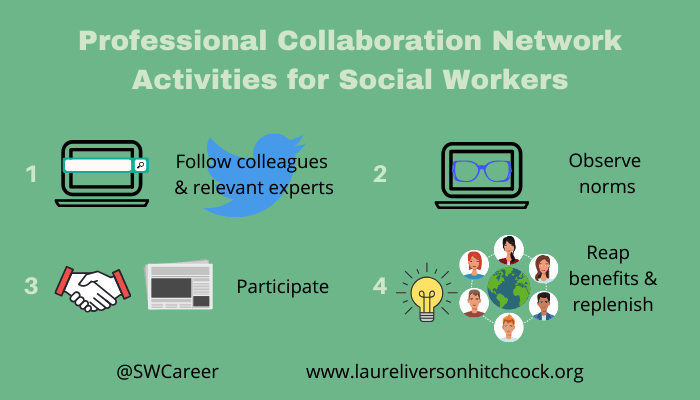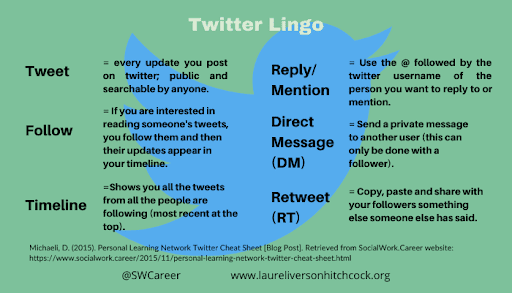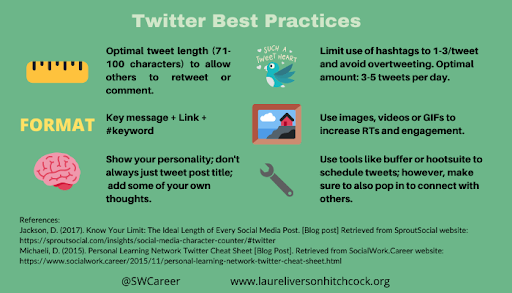Twitter for your Professional Collaboration Network (PCN)
Editor’s Note: This post is one in a series about how technology can be used to develop and sustain one’s professional network. The idea for this post came from a think tank hosted by the University at Buffalo’s School of Social Work in June 2019, looking for a way to teach students in their new online Doctorate of Social Program (DSW) program about how to develop key stakeholder networks in relation to a substantive topic area. In this series, we are exploring the concept of a Professional Collaboration Network (PCN), which are technology-mediated user-centered relationship constellations designed to enhance or enrich connections, knowledge, and professional opportunities. This post covers how you can use Twitter to create and support your PCN.
In light of our living in a time of rapid technological change and our professional mandate to keep up-to-date with the advances in our field, (Council on Social Work Education, 2015; National Association of Social Workers, 2018), social workers may benefit from building a professional collaboration network (PCN). We previously defined what a Professional Collaboration Network is this blog post: What is a professional collaboration network and why do you need one?

In essence, a PCN is created by social workers who connect with other professionals online for the purpose of learning and exchanging information. Prior to the ubiquitous use of the internet, professionals would typically keep up with the latest developments in their field via networking with their peers at conferences and continuing education opportunities, as well as via printed newsletters, magazines and trade publications. Nowadays, there are many technological tools to facilitate interactions with individuals across different disciplines, states or the world. PCNs typically include various online communities such as Twitter, LinkedIn, Facebook, social bookmarking sites and more.
Why Use Twitter for Your PCN
While you could develop your PCN on various social network platforms such as Facebook, LinkedIn and Twitter, this post will focus on the use of Twitter as the instrument of choice because it is a particularly effective tool to meet and learn from others. Many educators and other professionals use it as one of their primary forms of self-directed professional development (Richardson & Mancabelli, 2011). Twitter is a micro-blogging service network which allows you to send or receive short public posts, called tweets, of up to 280 characters. Tweets may contain text, links, and media such as photos, videos or a GIF.
You may follow and learn from experts and colleagues in any area on Twitter. Due to its asynchronous nature, it is possible to join in on conversations of interest anytime and from anywhere. Twitter Chats (specialty live chats that occur on the platform centered around various subjects) are the exception to this because they usually take place at pre-scheduled times. We offer the following steps to consider when using Twitter for your PCN, including tips and examples from the social work profession.
Create a Twitter Profile
Start by going to twitter.com and then completing the following steps:
- Fill out the New To Twitter, Sign Up box including your name, email and password.
- Click the sign up button.
- Create a unique username of 15 characters or less. Use either your real name or a brand name (if available) that you feel best represents the professional you. Alternatively, create a combination of your name and an adjective or profession. Examples of usernames for a few social workers:
- @laurelhitchcock for Laurel I Hitchcock (full name)
- @njsmyth for Nancy J. Smyth (initials of first and middle names + last name)
- @JimmySW (first name + SW for the social work profession)o
- @SWCareer for Dorlee Michaeli (editor of SocialWork.Career blog)
- Upload a professional looking photo.
- Add a background header photo related to your profession/brand/primary interest.
- Write a brief bio describing your work, main interests and include links to your LinkedIn profile and/or website.
Follow Relevant People and Organizations
To make your PCN as fruitful as possible, consider the learning goals you wish to achieve (see this blog post for questions to guide you in setting up learning goals), and then begin following the people and organizations who are most likely to provide helpful information in your areas of interest.
Begin by following colleagues whom you know and the people whom you know are experts in their fields. To follow a peer on Twitter, enter her/his/their name in the search field and then tap or click the Follow button on your colleague’s profile page. For example, you may wish to start with some of these social work twitter users:
- @AMLTaylor66 (Social work academic interested in digitalization)
- @BakkLouanne (DSW Program Director, @UBSSW)
- @CSocialWorkEd (Council on Social Work Education)
- @EBelluomini (PhD, MSW, assistant professor)
- @lauranissen (Social Work Academic. Futures practitioner/Futurist)
- @MattheaMarquart (Social worker, educator, lecturer at @ColumbiaSSW)
- @melaniesage (Assistant professor at @UBSSW)
- @nasw (the National Association of Social Workers)
- @newsocialworker (New Social Worker magazine)
- @OfficialMacroSW (Social workers creating content about macro social work)
- @socworkpodcast (Jonathan Singer, first social work podcast)
- @spcummings (Clinical assistant professor at the @UISchoolofSW)
- @StuckonSW (Blogger, care manager, social work adjunct at @UBSSW)
- @SWpodcast (University at Buffalo School of Social Work’s podcast series)
- @SWVirtualPal (Connecting social workers across the globe)
Follow some of the people that your colleagues and experts follow. To do this, go to the Twitter profile of a colleague, and tap/click on Following to see who they are following. Review those individuals’ bios and twitter feeds to see if they are people you’d find interesting to follow.
Once you get familiar with finding other users on Twitter, we encourage you to check out Lists and #Hashtags. First, a list is a group of Twitter users centered around a theme or topic such as social work educators, social work technology, end-of-life or career experts.
Without using a list, you may have hundreds or thousands of people’s tweets in your twitter feed, making it very hard to see the tweets of those whom you particularly value. Conversely, you may choose to follow a smaller number of individuals on a regular basis and periodically check out the twitter feed of a more general list. Lists can make it easy for you to selectively see the twitter feeds of your favorite people, or a group of experts on a particular topic vs. the twitter stream of all those people you follow.
To create your own list, tap or click on the small gear symbol next to the follow button of the profile of an individual you’d like to include in one of your lists, and then choose add/remove from lists. You can then include that person in an existing list or click the button that says create new list. Once you’ve created lists, they will always show up as options when you are adding people.
The lists you create may be public or private. When a list is public, others may see who you have included in your lists and choose to subscribe to one of your lists. When a list is private, only you can see who is included in that list. This may be helpful if you wanted to create a list of students in your class, or competitors.
Once you have a list made, you can use it to follow distinct conversations on Twitter. Click on any list and you’ll see a filtered Twitter stream. You can also add someone to a list and not follow them.
Aside from learning from someone else’s list or creating your own, you may also choose to subscribe to a list Tap or click on the small gear next to the follow button of the profile of an individual and choose View Lists. Tap or click on the first tab (owned) and then tap or click on a list you’d like to subscribe to, and click Subscribe. Check out Nancy’s Twitter list of social workers from around the world that includes over 1300 members and has almost 150 subscribers.
Next, you will want to identify keywords or #Hashtags for your areas of interest on Twitter. A hashtag is essentially a keyword around a certain event, theme or topic with “#” preceding it. Including a hashtag in your tweet on Twitter makes it searchable by other users, regardless of whether they are following you or not. Tweets with hashtags get twice as much engagement (views and shares) as those without (Lee, K., 2016). You can also use hashtags within Twitter’s regular search or advanced search option to find users tweeting about them. Look over the Twitter user’s bios and feeds to see which ones you feel are worthwhile adding to your Following list.
To figure out which are the best #hashtags to use in terms of popularity, search for topic keywords among twitter hashtags in either Twubs or Hashtagify.me. You might also be interested in Symplur’s Healthcare Hashtag Project, which include thousands of registered hashtags related to healthcare.
For example, if you are sharing a link related to end-of-life care, you could add #endoflife to it. Once someone clicks on that hashtag, they’ll be brought to a page that aggregates all of the posts with the #endoflife, in real-time.
Add only relevant hashtags to your tweets, and make sure to limit the number to 3 at the most. More than 3 tweets will make your post feel like it is spam, and reduce the likelihood of it being retweeted, or shared by others (Lee, 2016).
Observe the norms of Twitter
Learning the culture of a social media platform is an important digital literacy skill. Start by familiarizing yourself with Twitter’s lingo. Observe how Twitter users interact with one another, share resources and use hashtags.

Be a participant on Twitter
This means engaging with others on the platform rather than just observing or lurking. Here are some suggestions on how you can connect with others on Twitter:
- Respond to questions from other users in a friendly manner.
- Like and/or retweet valuable content (sharing while giving credit to the original provider of info).
- Find and share trustworthy articles and links in your area of expertise.
- Thank people who have retweeted your posts.
- Give credit to people who have provided the resources you’re sharing.
- Participate in Twitter chats of interest.
A Twitter chat is where a group of Twitter users meet at a set time to talk about a particular topic, using a designated hashtag for each tweet contributed (there is more about hashtags below). The Twitter chat host or moderator poses questions (usually designated with Q1, Q2…) to encourage interaction and prompt responses from participants (using A1, A2…). Chats typically last one hour. Twitter chats provide another opportunity to meet other users in your industry. For example, the #MacroSW Twitter Chat takes place every Thursday at 9PM. If you’d like to join, just show up on Thursday at 9PM and enter #MacroSW in the search window (or use a platform like Hootsuite or Tweetdeck to more easily follow the conversation). To find a Twitter chat in your area of interest, check out this list of social work twitter chats or the world’s largest list of twitter chats.

Monitor and replenish your network
As you participate and exchange resources with others, you will be kept informed of developments in your field and neighboring areas, enlarging your network of contacts, coming up with new ideas and ways to work and help others, and potentially coming across mentoring or other professional development opportunities. The success of your PCN is very much dependent upon how much you give back.
Below are some ways that you may choose to replenish your network along with an example of each method:
- Curate and share resources. For example, Free Mental Health Webinars is a monthly roundup of free webinars that @SWCareer curates. Dorlee also puts together monthly (or biweekly) roundups of select posts from around the web for social workers and therapists such as Best in Mental Health Jan 1 -19, 2020.
- Create and share new solutions/ideas. For example, #SWDE2019 – Incorporating Technology into Social Justice Assignments for Social Work Education is an illustration of how Laurel creates and shares presentations related to integrating technology into social work education.
- Collaborate with other users. As mentioned earlier, Laurel, Melanie & Nancy co-authored the book, Teaching Social Work with Digital Technology, after meeting through Twitter. Also, this blog post is the result of a collaboration of the authors who met via Twitter, and subsequently face-to-face in a PCN Think Tank meeting hosted by the University of Buffalo’s School of Social Work.
- Connect others. For example, Got Anger? Try HEArt Anger Management! is an interview that was facilitated by @njsmyth’s kind introduction of Howard Lipke, Phd to @SWCareer.
- Organize/guest speak at twitter chats. For example, @karenzgoda and a few other social workers serve as regular hosts of the weekly #MacroSW twitter chats. @drbarsky, @CaseyBohrman, @FinancialMSW and many other social workers have guest spoken on these chats.
- Tweet/blog learning from conferences. For example, Leadership and Getting Out of Our Way at #NatCon19 is an example of @StuckonSW pulling together some of his tweets and observations from a conference.
Finally, as you begin to get more comfortable with Twitter, you may wish to familiarize yourself with additional tools such as Buffer and Hootsuite to minimize the time you need to spend on the platform by scheduling posts in advance. That said, to be able to create and maintain the relationships you’ve made online, you’ll also need to sometimes pop in “live” to be responsive to others and engaged.
As you participate with your PCN on Twitter, you will inevitably end up both changing the communities you are engaged in as well as being changed by your participation in them. Please share your thoughts or questions in the comment section below. We would like to hear about how you are using Twitter to engage and collaborate with others in your professional circles.
References:
Council on Social Work Education. (2015). Educational policy and accreditation standards. Retrieved from https://www.cswe.org/getattachment/Accreditation/Accreditation-Process/2015-EPAS/2015EPAS_Web_FINAL.pdf.aspx
Lee, K. (2016). How to Use Hashtags: How Many, Best Ones, and Where to Use Them. Buffer. [Blog Post]. Retrieved from: https://buffer.com/library/a-scientific-guide-to-hashtags-which-ones-work-when-and-how-many.
Michaeli, D. (2015). Personal Learning Network Twitter Cheat Sheet [Blog Post]. Retrieved from SocialWork.Career website: https://www.socialwork.career/2015/11/personal-learning-network-twitter-cheat-sheet.html
National Association of Social Workers. (2017). Code of ethics of the National Association of Social Workers. Retrieved from https://www.socialworkers.org/About/Ethics/Code-of-Ethics/Code-of-Ethics-English.
Richardson, W., & Mancabelli, R. (2011). Personal learning networks: Using the power of connections to transform education. Bloomington, IN: Solution Tree Press.
How to cite this blog post:
Michaeli, D., Hitchcock, L.I, Young, J.A., Sage, M. Bakk, L. & Smyth, N.J. (2020, January 31). Twitter for your Professional Collaboration Network (PCN)[Blog Post]. Retrieved from Teaching & Learning in Social Work website: https://laureliversonhitchcock.org/2020/01/31/twitter-for-your-professional-collaboration-network-pcn/


